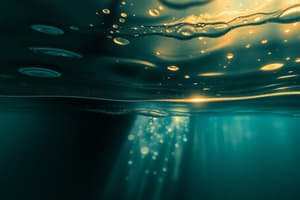Podcast
Questions and Answers
What are the basic concepts of pure water gain and loss?
What are the basic concepts of pure water gain and loss?
Pure water gain and loss involves understanding how the body acquires and loses water, impacting hydration and homeostasis.
What is the primary function of the Na+/K+-ATPase pump?
What is the primary function of the Na+/K+-ATPase pump?
The Na+/K+-ATPase pump moves three Na+ ions out of the cell and two K+ ions into the cell to generate concentration gradients.
Normal ECF osmolality is in the range of ________.
Normal ECF osmolality is in the range of ________.
275–295 mmol/kg water
ADH leads to renal sodium excretion.
ADH leads to renal sodium excretion.
What can cause cerebral dehydration?
What can cause cerebral dehydration?
Match the following mechanisms with their effects:
Match the following mechanisms with their effects:
What effect does an increase in plasma osmolality due to sodium have?
What effect does an increase in plasma osmolality due to sodium have?
What is the primary source of aldosterone regulation?
What is the primary source of aldosterone regulation?
What effect does increased extracellular fluid (ECF) tonicity have on the release of ADH?
What effect does increased extracellular fluid (ECF) tonicity have on the release of ADH?
Which substance is particularly influential in effective osmolality under physiological conditions?
Which substance is particularly influential in effective osmolality under physiological conditions?
What occurs during severe water depletion in relation to brain cells?
What occurs during severe water depletion in relation to brain cells?
What is the consequence of rapid fluid replacement after water depletion?
What is the consequence of rapid fluid replacement after water depletion?
What is primarily responsible for cerebral shrinkage during hypertonicity?
What is primarily responsible for cerebral shrinkage during hypertonicity?
Which mechanism allows for sodium and water excretion in response to increased blood volume?
Which mechanism allows for sodium and water excretion in response to increased blood volume?
How does plasma osmolality affect the movement of water across cell membranes when sodium levels rise?
How does plasma osmolality affect the movement of water across cell membranes when sodium levels rise?
What is the main consequence of the Na+/K+-ATPase pump failing to function properly?
What is the main consequence of the Na+/K+-ATPase pump failing to function properly?
Which of the following accurately describes isosmotic movement of water?
Which of the following accurately describes isosmotic movement of water?
What role does the Na+/K+-ATPase pump play in glucose transport?
What role does the Na+/K+-ATPase pump play in glucose transport?
Which factor primarily drives water out of the intravascular space into the interstitial space?
Which factor primarily drives water out of the intravascular space into the interstitial space?
What happens to osmolality when water is lost from the extracellular fluid (ECF)?
What happens to osmolality when water is lost from the extracellular fluid (ECF)?
What is the typical range for normal extracellular fluid (ECF) osmolality?
What is the typical range for normal extracellular fluid (ECF) osmolality?
How does the Na+/K+-ATPase pump consume energy in the body?
How does the Na+/K+-ATPase pump consume energy in the body?
What generally happens to water distribution in the body when there is a significant loss of sodium?
What generally happens to water distribution in the body when there is a significant loss of sodium?
Flashcards are hidden until you start studying
Study Notes
Water and Electrolyte Balance
- Body Water Composition: Water is the most abundant molecule in the human body.
- Electrolyte Distribution: The extracellular fluid (ECF) is primarily composed of sodium, while the intracellular fluid (ICF) is rich in potassium.
- Na/K ATPase Pump:
- This pump is essential for maintaining cell membrane potential.
- It moves three sodium ions out of the cell and two potassium ions into the cell with each cycle of ATP hydrolysis.
- It is responsible for generating the typical sodium and potassium gradients across the cell membrane.
- The sodium gradient is used for coupled transport of glucose and other substances.
- Approximately one-third of all ATP in a resting body is consumed by this pump.
- If the pump malfunctions, the concentration gradients of sodium and potassium can be disrupted, impacting cell signaling.
- Water Distribution: Water moves from the intravascular space based on pressure differences.
- Hydrostatic Pressure: This pressure drives fluid from blood vessels into the interstitial space.
- Oncotic Pressure: This pressure, driven by albumin, holds water within the intravascular compartment.
- Osmotic Pressure: This pressure pulls water from areas of low solute concentration to areas of high solute concentration.
Osmolality
- Definition: Osmolality is a measure of the concentration of osmotically active solutes in a solution.
- Range: Normal extracellular fluid osmolality ranges from 275 to 295 mmol/kg of water.
- Water Loss and Osmolality: Water loss from the extracellular fluid increases osmolality, leading to water movement from the ICF to the ECF to equalize osmolality.
- Calculation: Calculated osmolality:
2 x [Na+] + [urea] + [glucose]
Regulation of Hydration Status
- Mechanisms of Regulation:
- Glomerular Filtration Rate (GFR): The kidneys regulate sodium and water excretion through the GFR.
- Aldosterone: This hormone, secreted by the adrenal glands, promotes renal retention of sodium and water in response to decreased renal perfusion.
- Antidiuretic Hormone (ADH): This hormone, released from the hypothalamus, increases pure water retention in response to increased extracellular fluid tonicity or decreased blood volume.
- Atrial Natriuretic Factor (ANF): This hormone, secreted by the cardiac atria, promotes renal excretion of sodium and water in response to increased blood volume.
Osmolality vs Tonicity
- Hypothalamic Osmostat: It governs ADH release and thirst sensation, responding acutely to small changes in plasma osmolality.
- Cell Membrane Permeability: The cell membrane is selectively permeable to various solutes.
- Urea and alcohol are freely permeable.
- Osmolality and Tonicity:
- An increase in plasma osmolality due to sodium increases osmotic pressure across the cell membrane, causing water to move out of the cell to equalize osmolalities.
- An increase in plasma osmolality due to urea does not have this effect because urea readily crosses the cell membrane.
- Effective osmolality (tonicity) under physiological conditions is primarily determined by plasma sodium concentration.
Cerebral Effects
- Brain Dehydration: Hypertonicity can cause cerebral dehydration, leading to:
- Osmolar imbalance and cerebral shrinkage.
- Rupture of blood vessels due to pressure.
- Brain Swelling: Hypertonicity can also cause cerebral swelling (edema) due to water moving into the intracellular space.
- This can lead to compression and neurological issues.
- Brain Adaptation: The brain can adapt to changes in osmolarity by altering the content of "osmolytes" - organic compounds that help regulate osmotic pressure.
Blood Volume
- Water Depletion: Severe water depletion can cause:
- Cerebral dehydration leading to cerebral bleeding.
- Temporary cerebral shrinkage due to movement of ions into cells.
- If dehydration persists, the brain compensates by synthesizing osmolytes.
- Excessive Fluid Replacement: This can lead to cerebral edema due to rapid water movement into cells.
Osmolal Gap
- Normal Osmolal Gap: The measured osmolality (mmol/kg of water) and calculated osmolarity (mmol/L of solution) are typically very similar.
- A normal gap is generally considered to be between 0 and 10 mmol/kg.
- Significance: A significant gap (greater than 10 mmol/kg) can indicate the presence of substances in the blood that are not being accounted for by the standard calculation. This could be due to:
- Alcohol intoxication
- Mannitol administration
- Presence of other toxins or substances in the blood.
Water and Electrolyte Balance
- Water is the most abundant molecule in the human body.
- Electrolyte compositions of the ECF and ICF differ, with sodium predominant in the extracellular space and potassium in the intracellular space.
- The Na/K ATPase pump is responsible for maintaining these gradients, moving three Na+ ions out of the cell and two K+ ions into the cell for each ATP hydrolysis.
- This pump is essential for cell signaling and coupled transport of glucose and other substances.
Water Distribution
- Water moves between the intravascular and interstitial spaces based on pressure differences.
- Hydrostatic pressure drives fluid from vessels into the interstitial space.
- Oncotic pressure, primarily driven by albumin, holds water within the intravascular compartment.
- Osmotic pressure pulls water from a low-solute to a high-solute compartment.
Osmolality
- Osmolality represents the concentration of osmotically active solutes in a solution.
- Normal ECF osmolality is 275-295 mmol/kg water.
- Water loss from the ECF increases osmolality, leading to water shifting from the ICF to the ECF.
- Osmolality can be measured directly or calculated using the following formula: Osmolality = 2 x [Na+] + [urea] + [glucose].
Regulation of Hydration Status
- The kidney, through GFR, regulates Na+ and water excretion.
- Aldosterone, secreted by the adrenal glands, retains Na+ and water in response to decreased renal perfusion.
- ADH, released from the hypothalamus, causes pure water retention in response to increased ECF tonicity or decreased blood volume.
- ANF, released from cardiac atria, promotes Na+ and water excretion in response to increased blood volume.
Osmolality vs Tonicity
- The hypothalamic osmostat controls both ADH release and thirst sensation, being highly sensitive to changes in plasma osmolality.
- Cell membranes are selectively permeable to solutes, with urea and alcohol being freely permeable.
- Sodium-induced increases in plasma osmolality lead to increased osmotic pressure across the cell membrane, drawing water from the cell.
- Urea-induced increases in plasma osmolality do not cause this effect due to its free permeability between the ICF and ECF.
- Tonicity, or effective osmolality, under physiological conditions is primarily determined by plasma sodium concentration.
Cerebral Water Balance
- Changes in cell volume, especially in the brain, can cause complications.
- Hypertonicity can lead to cerebral dehydration, causing osmolar imbalance and potential vessel rupture.
- Hypotonicity can cause cerebral swelling (edema) and compression.
- The brain adapts to these conditions through changes in the content of “osmolytes”.
Water Depletion
- Severe water depletion causes cerebral dehydration, potentially leading to cerebral bleeding.
- Short-term cerebral shrinkage is limited by the movement of extracellular ions into cerebral cells, a process known as an osmotic shift of water.
- If dehydration persists, brain cells adapt by synthesizing osmotically active organic compounds (osmolytes).
- Excessive fluid replacement can cause cerebral edema due to rapid water movement into the ICF.
Osmolal Gap
- The measured osmolality (mmol/kg water) and calculated osmolarity (mmol/L solution) are typically very similar.
- A normal osmolal gap is generally considered to be ≤ 10 mmol/kg water.
Studying That Suits You
Use AI to generate personalized quizzes and flashcards to suit your learning preferences.



